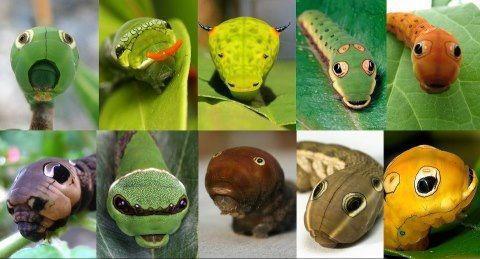Richard Conniff's Blog, page 87
October 1, 2012
An Eyeful of Natural Selection

(Photo selection from Rainforest Journeys)
You are looking at the hind end of various rainforest caterpillars. But if you thought for just a moment that you were looking at snakes or lizards, well, so do a lot of predators. And that’s the point.
These false eye spots give defenseless caterpillars a moment of protection, startling birds, for instance, into sudden retreat. The caterpillars that don’t have that startle effect get eaten up. Thus natural selection has made the trait widespread in the caterpillar world.

September 26, 2012
Chicago Coyotes Don’t Cat Around

Not so Wile E.?
Well, I don’t actually believe it. A dog cousin–or for that matter, any mammal–that’s 100 percent monogamous? Come on.
It would certainly turn Mark Twain’s low opinion of the species on its head. In Roughing It, he wrote: “The cayote [sic] is a living, breathing allegory of Want. He is always hungry. He is always poor, out of luck and friendless. The meanest creatures despise him and even the flea would desert him for a velocipede.”
Instead, a new study done in Chicago and surrounding counties suggests that the species is actually a bastion of sober Midwestern values.
Here’s the story, from Science Daily:
Coyotes living in cities don’t ever stray from their mates, and stay with each other till death do them part, according to a new study.
The finding sheds light on why the North American cousin of the dog and wolf, which is originally native to deserts and plains, is thriving today in urban areas.Scientists with Ohio State University who genetically sampled 236 coyotes in the Chicago area over a six-year period found no evidence of polygamy — of the animals having more than one mate — nor of one mate ever leaving another while the other was still alive.
This was even though the coyotes exist in high population densities and have plenty of food to eat, which are conditions that often lead other dog family members, such as some fox species, to stray from their normal monogamy.
To cat around, as it were.
“I was surprised we didn’t find any cheating going on,” said study co-author Stan Gehrt, a wildlife ecologist with Ohio State’s School of Environment and Natural Resources. “Even with all the opportunities for the coyotes to philander, they really don’t.
“In contrast to studies of other presumably monogamous species that were later found to be cheating, such as arctic foxes and mountain bluebirds, we found incredible loyalty to partners in the study population.”
The study appears in a recent issue of The Journal of Mammalogy.
The loyalty of coyotes to their mates may be a key to their success in urban areas, according to Gehrt.
Not only does a female coyote have the natural ability to produce large litters of young during times of abundance, such as when living in food-rich cities, she has a faithful partner to help raise them all.
“If the female were to try to raise those large litters by herself, she wouldn’t be able to do it,” said Gehrt, who holds appointments with the university’s Ohio Agricultural Research and Development Center and Ohio State University Extension. “But the male spends just as much time helping to raise those pups as the female does.”
Unlike the males of polygamous species, a male coyote “knows that every one of those pups is his offspring” and has a clear genetic stake in helping them survive, Gehrt said.
The research was done in Cook, Kane, DuPage and McHenry counties in northeast Illinois. All are in greater Chicago, which is home to about 9 million people and is the third-largest metropolitan area in the U.S.
It’s also home to an estimated 1,000 to 2,000 coyotes. Gehrt has previously said he “couldn’t find an area in Chicago where there weren’t coyotes.”
“You’ve got lots of coyotes in this landscape,” said senior author Cecilia Hennessy, who conducted the study as a master’s degree advisee of Gehrt and is now a doctoral student at Purdue University in Indiana. “You’ve got territories that abut each other. And coyotes can make long-distance forays. So you’d think, based on previous investigations of dog behavior, that cheating would be likely.
“But to find nothing, absolutely nothing, no evidence whatsoever of anything that wasn’t monogamy, I was very surprised by that,” she said.
The finding came through a wider study of Chicago-area coyotes that Gehrt has led since 2000. As the largest study ever on urban coyotes, it’s a long-term effort to understand the animals’ population ecology, how they adapt to urban life and how to reduce their conflicts with people.
“A powerful part of the new paper is that we have long-term field work, behavior observations, to accompany Cecilia’s genetic work,” Gehrt said. “So many genetic studies only analyze samples but know very little about their subjects, whereas we follow these individuals nearly every day and often to the completion of their lives. It’s a nice mesh of lab and field work.”
The scientists used live traps — either padded foothold traps or non-choking neck snares — to catch the coyotes for the study, although pups were simply dug from their dens and held by hand. Small blood and tissue samples were taken from all the animals. The adults, which were anesthetized, also were fitted with radio-collars for tracking their movements and ranges. Afterward, all the coyotes were released where they were caught.
Later, Hennessy, who previously was a plant genetics technician and biology major at the University of Cincinnati, used genetic techniques in the lab to test the animals’ DNA and determine their family trees.
Coyotes maintain monogamy through long-term pair bonding, a term meaning an animal stays with the same mate for more than one breeding season, and sometimes for many.
A male coyote, for his part, practices diligent mate guarding — keeping other males away from the female.
During estrus, which is the time when the female can become pregnant, the pair “will spend all their time together — running, finding food, marking their territory. They’ll always be right at each other’s side.”
“We’ve been able to follow some of these alpha pairs through time, and we’ve had some of them stay together for up to 10 years,” Gehrt said. “They separate only upon the death of one of the individuals, so they truly adhere to that philosophy, ‘Till death do us part,’ ” Hennessy said.
Hennessy, C. A., J. Dubach and S. D. Gehrt. Long-term pair bonding and genetic evidence for monogamy among urban coyotes (Canis latrans). Journal of Mammalogy, 93(3):732-742; 2012

September 25, 2012
Why Not to Let Your Cat Outside
Mine got away this morning and promptly returned with a gift, alive and twitching, which he hoped to bring inside. At least it was a chipmunk, not a bird.
I’m all for cats doing what’s in their DNA when they are killing mice in my house. But allowed to wander outside, house cats kill 500 million birds each year.
Letting them loose in the neighborhood is like subsidizing mercenaries to roam the streets and kill dogs, cats, and children. Because, you know, they are just doing what’s in the DNA.

September 24, 2012
The Glory of Geckoes
Peter Naskrecki has a fine blog item today at his Smaller Minority photo blog. It’s about his work as a naturalist and photographer visiting Madagascar. Here’s an excerpt:
When I first held the Giant Leaf tailed gecko (U. fimbriatus) in my hand after catching it in the rainforest of northern Madagascar, it felt as if I were holding a living, breathing beanie baby. It was the size of small puppy, and its skin was velvet-soft and warm. The gecko’s hands grasped my fingers the way a newborn holds its parent’s finger – softly but firmly at the same time. Having this animal sit in my hand was one of the most pleasant tactile experiences of my life.
Giant leaf tailed gecko (Uroplatus fimbriatus), proudly displaying its mouth full of teeth (Photo by Piotr Naskrecki)
Of course, Leaf tailed geckos are not sweet, fuzzy toys – like all geckos, they are efficient killing machines, predators capable of catching and swallowing remarkably large prey. The smiley face of the gecko hides incredibly sharp teeth, and lots of them. Leaf tailed geckos have the highest number of teeth of any amniote (which includes most of terrestrial vertebrates) – their lower jaw can have 97-148, while the upper between 112 and 169. That’s, potentially, 317 teeth! To put it in perspective, other geckos have between 100-180 teeth, while our puny human jaws carry only 32 teeth.
Leaf tail geckos are high masters of camouflage, and this is one of the reasons why so little is known about their biology (Photo by Piotr Naskrecki)
Why so many? Nobody knows for sure, because virtually nothing is known about their feeding behavior in the wild. In captivity they will eat almost anything that moves, but in their native habitat, the wet and humid forests of Madagascar, they may be targeting frogs, which are a remarkably species-rich and abundant group in that part of the world. A huge number of small, sharp teeth is likely to help hold such slippery prey. A higher than usual number of teeth may also be very useful in capturing moths, whose scale-covered bodies are as difficult to grasp as those of wet amphibians.

September 20, 2012
The Genetics of Colonization
A study out today proposes a possible genetic basis for the human expansion out of Africa roughly 40,000 years ago. Here’s part of the press release:
A genetic mutation that occurred thousands of years ago might be the answer to how early humans were able to move from central Africa and across the continent in what has been called “the great expansion,” according to new research from Wake Forest Baptist Medical Center.
By analyzing genetic sequence variation patterns in different populations around the world, three teams of scientists from Wake Forest Baptist, Johns Hopkins University School of Medicine and the University of Washington School of Medicine, Seattle, demonstrated that a critical genetic variant arose in a key gene cluster on chromosome 11, known as the fatty acid desaturase cluster or FADS, more than 85,000 years ago. This variation would have allowed early humans to convert plant-based polyunsaturated fatty acids (PUFAs) to brain PUFAs necessary for increased brain size, complexity and function. The FADS cluster plays a critical role in determining how effectively medium-chain PUFAs found in plants are converted to the long-chain PUFAs found in the brain.
This research is published online today in PLOS One.
Archeological and genetic studies suggest that homo sapiens appeared approximately 180,000 years ago, but stayed in one location around bodies of water in central Africa for almost 100,000 years. Senior author Floyd H. “Ski” Chilton, Ph.D., professor of physiology and pharmacology and director of the Center for Botanical Lipids and Inflammatory Disease Prevention at Wake Forest Baptist, and others have hypothesized that this location was critical, in part, because early humans needed large amounts of the long-chain PUFA docosahexaenoic acid (DHA), which is found in shellfish and fish, to support complex brain function.
“This may have kept early humans tethered to the water in central Africa where there was a constant food source of DHA,” Chilton said. “There has been considerable debate on how early humans were able to obtain sufficient DHA necessary to maintain brain size and complexity. It’s amazing to think we may have uncovered the region of genetic variation that arose about the time that early humans moved out of this central region in what has been called the ‘great expansion.’”
Once this trait arose, the study shows that it was under intense selective pressure and thus rapidly spread throughout the population of the entire African continent. “The power of genetics continually impresses me, and I find it remarkable that we can make inferences about things that happened tens of thousands of years ago by studying patterns of genetic variation that exist in contemporary populations,” said Joshua M. Akey, Ph.D., lead scientist at the University of Washington.
This conversion meant that early humans didn’t have to rely on just one food source, fish, for brain growth and development. This may have been particularly important because the genetic variant arose before organized hunting and fishing could have provided more reliable sources of long-chain PUFAs, Akey said.
Citation: Mathias RA, Fu W, Akey JM, Ainsworth HC, Torgerson DG, et al. (2012) Adaptive Evolution of the FADS Gene Cluster within Africa. PLoS ONE 7(9): e44926. doi:10.1371/journal.pone.0044926

September 18, 2012
Bashing Men as the New National Pastime (The Male Advantage–part 1)
My latest, for Men’s Health magazine:
On a radio show one morning recently, a female professor at a well-known university tossed off the thought that, if men are just going to hang out with their pals at the bar every night, women will take a pass on having kids with them. She didn’t cite any studies, and she almost certainly didn’t know any men who fit that description. But it didn’t matter.
Casually disparaging the entire male gender is not only the last socially acceptable prejudice, it’s a national pastime. Later I asked some friends to name a few things men do well and the answers ranged from “Leave the toilet seat up” to a flat out, “Nothing.” Men have become a necessary evil—and maybe not all that necessary, once artificial sperm moves out of the laboratory and into the real world. At the same time, women have become so disproportionately admired by both genders that psychologists have dubbed this the “Women Are Wonderful Effect.”
And, Lord knows, they are. But I was hoping someone would pipe up to say that men and women aren’t really all that different, and that both do plenty of things well. Feminists used to say something like that, for the purpose of moving women into jobs traditionally held by men. So you would hardly expect them to argue now that men are a defective or inferior gender–unless they have completely forgotten how destructive it was when such things were said about women.
And yet that has somehow become the default assumption for society at large: Boys raise their hands in class more often than girls so they need to be ignored. Boys are disruptive in school so they need to be medicated (almost three times as often as girls). Boys drop out of school more and fail to attend college or grad school at the same rate as girls, so let’s forget them and focus on helping the girls. Young men are more likely to be aggressive and violent, so instead of spending money to educate them, we should spend it to lock them behind bars (especially if they are young and black, a group which has seen its incarceration rate rise to five times what it was 20 years ago). Above all, men are defective as fathers. So 40 percent of kids are now born to single moms, up from about five percent in 1960. And hardly anyone acts as if this is a catastrophe in the making, even though the numbers are much worse in low-income homes where kids–and moms–need dads most. When marriages end in divorce, finally, custody of the children still goes to mom seven times out of ten. Because conventional wisdom says dad is a bum.

Taking Chances is a Guy’s Only Hope (The Male Advantage–part 2)
 Over the past 25 years, the social sciences “have done a really good job of cataloging things men do badly–men and depression, men and violence, men and drugs—and very little on the other side,” says Matt Englar-Carlson, PhD., a counseling professor at California State University-Fullerton. “Would this research describe me? Would it describe my friends? Are we doing a disservice if all we educate people about is this dark side of masculinity? Does it create a bias against men?” The University of Connecticut’s James O’Neil, PhD, says there is no question about it: “Sexism is as bad against men as it was against women.” O’Neil started out in the 1970s struggling to get men to admit that they have problems. But these days, together with a handful of other mental health providers, he tries to show patients that positive masculinity is not a contradiction in terms.
Over the past 25 years, the social sciences “have done a really good job of cataloging things men do badly–men and depression, men and violence, men and drugs—and very little on the other side,” says Matt Englar-Carlson, PhD., a counseling professor at California State University-Fullerton. “Would this research describe me? Would it describe my friends? Are we doing a disservice if all we educate people about is this dark side of masculinity? Does it create a bias against men?” The University of Connecticut’s James O’Neil, PhD, says there is no question about it: “Sexism is as bad against men as it was against women.” O’Neil started out in the 1970s struggling to get men to admit that they have problems. But these days, together with a handful of other mental health providers, he tries to show patients that positive masculinity is not a contradiction in terms.
 So let’s go back to that question I put to my friends: Is there anything men do well? Or as Florida State University psychologist Roy F. Baumeister, Ph.D., phrased it in the title of his recent book, Is There Anything Good about Men? Baumeister argues that the major differences between men and women have to do with motivation rather than ability, and the motivation comes from a highly sensitive arena in which women have traditionally succeeded far more consistently than men: Reproduction.
So let’s go back to that question I put to my friends: Is there anything men do well? Or as Florida State University psychologist Roy F. Baumeister, Ph.D., phrased it in the title of his recent book, Is There Anything Good about Men? Baumeister argues that the major differences between men and women have to do with motivation rather than ability, and the motivation comes from a highly sensitive arena in which women have traditionally succeeded far more consistently than men: Reproduction.
The single most underappreciated fact about gender. Ask yourself a simple question: What percentage of your ancestors were men? Since everybody who ever lived had a mother and a father, you might reasonably think it’s half. But recent DNA analysis indicates that we are in fact descended from about twice as many women as men. That’s because, for much of our evolutionary history, simply being a woman was almost a sure ticket to reproduction; perhaps 80 percent of all women who ever lived became mothers. But a man had to acquire power and status to attract a woman and father her children. So a much smaller share of all men—perhaps 40 percent—managed to win the race, often becoming not just serial monogamists, but serial polygamists. These Big Daddies turn up repeatedly in the family tree (meaning fewer total male ancestors). Meanwhile, the majority of men died childless, evolutionary dead ends.
So far this doesn’t sound so good for men. But Baumeister calls it “the single most underappreciated fact about gender.” The message to women was “Play it safe, be like everyone else, don’t blow a sure thing.” And to men? “Take chances, play hard, stand out: It’s your only hope.”

The Culture Builder Hypothesis (The Male Advantage–part 3)
 That’s why the first thing men do well is compete. In fact, we can hardly help competing. I row with a bunch of guys in their 50s and 60s, well past the age when this sort of thing is supposed to matter. I don’t think we’re competing for women; that’s what biologists call an ultimate cause. But the proximate cause is that we just like to beat each other. If you put us in doubles and send us around the lake a few times, our “steady state” row invariably escalates into a race. Then we lean on our oars catching our breath just enough to start talking trash. (I lose at rowing, but pull ahead on comic insults.) The only reason this is a problem is that society now regards the almost automatic male urge to compete as silly, annoying, and often destructive. But here’s another way to look at it:
That’s why the first thing men do well is compete. In fact, we can hardly help competing. I row with a bunch of guys in their 50s and 60s, well past the age when this sort of thing is supposed to matter. I don’t think we’re competing for women; that’s what biologists call an ultimate cause. But the proximate cause is that we just like to beat each other. If you put us in doubles and send us around the lake a few times, our “steady state” row invariably escalates into a race. Then we lean on our oars catching our breath just enough to start talking trash. (I lose at rowing, but pull ahead on comic insults.) The only reason this is a problem is that society now regards the almost automatic male urge to compete as silly, annoying, and often destructive. But here’s another way to look at it:
Male social skills are the basis for civilization. Men don’t just compete one-on-one. We band together to compete against other groups, and we have been doing so since our hairy ancestors first figured out that groups were a more effective way to hunt and to wage tribal warfare. For better or worse, that’s where we learned our social skills. And it has supposedly turned us into social morons, unable to savor the deep emotional connections that resonate through the close relationships among women.
Male socializing can admittedly be fairly shallow: If women sometimes fake orgasms, men can fake entire relationships, and this can lead to, oh, misunderstandings. But our shallow social style is also functional, enabling us to move easily though a shifting array of alliances and not get bogged down too much by emotions. In a game of shirts-and-skins, or in a corporate takeover, switching sides can turn the guy you were just hating into your temporary best pal, and then you both focus together on the job at hand. (You can hate each other later.)
Men aren’t worse than women at socializing, just different. It’s a tradeoff, says Baumeister, with the social strengths of each balancing the weaknesses of the other, to the benefit of all: “While women concentrated on the close relationships that enabled the species to survive, men created the bigger networks of shallow relationships, less necessary for survival but eventually enabling culture to flourish.”
 These networks turned out to be perfectly suited to building large social systems, says Dutch psychologist Mark van Vugt, Ph.d: Group competition generated a psychology in men “which allows them to connect with large groups of, effectively, strangers and rely on them to build alliances, and once you have that, all sorts of things become possible”– tribes, small villages, political factions, nations, empires, “and even businesses, which consist of large groups of strangers cooperating with one another,” almost all founded and built up by men. You could call van Vugt’s idea the “Culture Builder” hypothesis. Unfortunately–and this is how it always seems to go for men–he dubbed it the “Warrior Hypothesis” instead.
These networks turned out to be perfectly suited to building large social systems, says Dutch psychologist Mark van Vugt, Ph.d: Group competition generated a psychology in men “which allows them to connect with large groups of, effectively, strangers and rely on them to build alliances, and once you have that, all sorts of things become possible”– tribes, small villages, political factions, nations, empires, “and even businesses, which consist of large groups of strangers cooperating with one another,” almost all founded and built up by men. You could call van Vugt’s idea the “Culture Builder” hypothesis. Unfortunately–and this is how it always seems to go for men–he dubbed it the “Warrior Hypothesis” instead.

A Few Things Men Do Well (The Male Advantage–part 4)
Men excel at hierarchies. Our male predecessors tended to favor the old command-and-control style of managing businesses—and the switch to a looser, more collaborative style is one of the happier improvements brought about by the arrival of women in management. But hierarchies still rule the workplace, and though it’s not fashionable to say so, this is a good thing, even if they happen to be a male specialty. In a classic Stanford University study, groups of male college freshmen put in a room and given a problem to solve needed less than fifteen minutes to sort themselves into hierarchies. That’s because boys start choosing up sides and figuring out who’s in charge on the pre-school playground, and never really stop. Girls are just a little wobblier when it comes to hierarchies.
Sometimes no doubt men get carried away with the power struggles. I was once talking to executives at an auto manufacturer about the notion that a round table can make boardroom discussions more egalitarian. Then the head of sales set us straight: “The round table just makes it easier for everybody to see the kill.” But most of the time, the male strategy of establishing who’s in charge and where all the players fit in serves to reduce needless aggression, set goals, coordinate moving parts, and get business done.
Men work harder. Modern society has demonstrated that women can learn to be almost as shallow and competitive as we are. But they work shorter hours, by more than 25 percent on average, typically so they can spend more time on family and friends. In a recent study of the would-be careerists who earned degrees since 1990 from the University of Chicago’s Booth School of Business, virtually all of the men—but only 62 percent of the women–were still employed full-time 10 or more years out. Likewise, after seven years of post-college training, only 67 percent of women pediatricians work full-time. Taking care of their own kids evidently comes to seem more important than taking care of other peoples’.
Men work longer hours because we’re more motivated, says Baumeister. “Men are much more interested than women in forming large groups and working in them and rising to the top in them.” We have a richer history at it, and we’re also driven to compete on the job by the deeply-ingrained memory of our dismal reproductive odds.
Men are smarter than women. O.k., we’re stupider, too. In fact, men tend to show up more at the extremes not just for intelligence (geniuses versus dolts) but for a variety of traits, including height, weight, body mass index, performance in the 60 meter dash, and personality. “Whether we are talking about kindness versus cruelty, curiosity versus close-mindedness, wisdom versus immature pigheadedness, self control versus self-indulgence, or humility versus narcissism,” says Baumeister, “there are more men than women at both the good and the bad extremes.”
Given this tendency, it probably shouldn’t be so surprising that there are more men at the top of most organizations. The opposite extreme is true, too: There are also more men at the bottom. (Oddly, women never mention this when they complain that a “glass ceiling” of discrimination holds them down.) In fact, there’s a trap door to the sub-sub-basement–and, gentlemen, for us, admission is free. For much of our history, men have quietly accepted that the dark and dirty work of the world—digging the coal, stoking the furnaces, hammering the steel, collecting the garbage–is our lot.

Die Laughing (The Male Advantage–part 5)

Fireman’s helmet from the World Trade Center collapse (Photo for National Geographic by Ira Block)
We are expendable. Feminism to the contrary, everybody understands that it’s still a world where women and children come first. And we’re o.k. with that, because when it comes to survival of the species (or the family) men are just not as precious. But that context can sometimes make the modern urge to focus on female victims—while stepping gingerly past heaped-up male corpses—a little unseemly. For instance, a recent New York State report on post-9/11 deaths among first responders at the World Trade Center solemnly noted that 13 percent of victims were women. You had to go to a table to find out that the other 87 percent were … oh, never mind,
In the 1990s, a similar slant led the feminist writers Gloria Steinem and Naomi Wolf to report that 150,000 American women were dying each year from anorexia, to free themselves from “female bondage.” Wolf wondered “How would America react to the self-immolation by hunger of its favorite sons?” It was a good cause. But a reporter checked with the National Center for Health Statistics and found that the actual number of deaths per year from anorexia was more like 100. And as to how society would react if its sons were dying? We already know that. In 2010, 4547 Americans died in accidents on the job and 92 percent of them were … not women. The death toll is even more skewed for policemen, firemen, soldiers, and even journalists. And men are o.k. with all of that. But if we are going to be expendable, our deepest wish is to go out in a worthy cause, and in the hope that someone will notice.
We take risks just to be entertaining, too. Wow, we really are stupid, aren’t we? Let’s go back to our penchant for extremes. From the fetal stage on, males respond more directly than females to environmental circumstances, both good and bad. In the animal world, this results in greater variability of traits like stags’ antlers or peacocks’ tails. It’s evolution at work, sorting males into winners and losers, Big Daddies and Dead-Enders. Meanwhile, females cruise through on an even keel.
Going to extremes, in all kinds of sensible and nonsensical ways, is how males try to stand out, win attention, even perhaps persuade a woman that we might not be all that expendable, after all. It’s courtship behavior, says psychologist Geoffrey S. Miller, Ph.d., author of The Mating Mind. Human culture has been dominated by males “because human culture is mostly courtship effort, and all male mammals invest more energy in courtship. Male humans paint more pictures, record more jazz albums, write more books, commit more murders, and perform more strange feats to enter the Guinness Book of Records.” We come up with more Big Ideas (about 99.5 percent of all Nobel Prize winners have been men), we invent more stuff (we register about 94 percent of all patents) and we tell more jokes (most of us do not yet have our Nobel Prizes or patents, but GSOH, a good sense of humor, is one of the main things women look for in personal ads).








